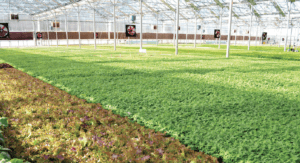
Feb 19, 2020BrightFarms continues growth with greenhouse locations
New York-based packaged salads company BrightFarms entered 2020 with plans to open a 250,000-square-foot greenhouse in Snyder County, Pennsylvania – its second greenhouse in the state.
The greenhouse will produce more than 2 million pounds of leafy salad greens and herbs a year, to be delivered to Pennsylvania supermarkets within 24 hours of harvest, according to a BrightFarms news release.
BrightFarms’ North Carolina greenhouse, for which construction was set to begin early this year, will be the company’s sixth and one of its largest locations to date.
“Today’s consumers are searching for produce that’s fresher, safer and responsibly grown. It’s the reason that locally grown food has become the No. 1 purchase driver in produce for supermarkets,” said Steve Platt, CEO of BrightFarms. “We are incredibly grateful for the support from Governor Cooper and the North Carolina Department of Commerce and look forward to bringing local, pesticide-free leafy greens to North Carolina and neighboring states.”
Platt took over as CEO in August 2019, while the company’s founder, Paul Lightfoot, continues as the company’s president and founder. Both Platt and Lightfoot are members of the board of directors.
In early 2019, BrightFarms announced plans for new greenhouse farms to be built in Massachusetts, New York and North Carolina by the end of 2019. BrightFarms also has operations in Selinsgrove, Pennsylvania; Wilmington, Ohio; Rochelle, Illinois; Elkwood, Virginia and Yardley, Pennsylvania.
The business model for each greenhouse is to supply the surrounding urban area, shortening the supply chain.
BrightFarms grows leafy salad greens and herbs including spring mix, spinach, baby kale, romaine and arugula. The company describes its local greens, which are grown in a safe, secure and clean indoor environment without the use of pesticides, as beyond organic.
By growing produce close to its consumers, BrightFarms’ produce is delivered to supermarkets in as little as 24 hours of harvest, about a week faster than leafy greens grown on the West Coast.
A natural setting
Josh Norbury, vice president of operations for BrightFarms, is playing a part in the growing company’s day-today greenhouse operations.
“Greenhouses utilize the natural resources a little better,” Norbury told Vegetable Growers News. “Sunlight is free and abundant. We want to take advantage of that.”
The production method allows BrightFarms to control inputs so customers get what they need – healthy and tasty products.
BrightFarms operates near major population centers, getting fresh produce on trucks and on shelves within 24-48 hours.
The hydroponic growing process of leafy uses an estimated 80% less water, 90% less land and 95% less shipping fuel than West Coast farms.

The produce for the most recently developed facility will be delivered to Pennsylvania supermarkets within 24 hours of harvest, roughly five to seven days faster than conventional leafy greens grown on the West Coast.
The hydroponic approach “gives the plants exactly what they need to thrive – not more than they need,” Norbury said.
“We’ve developed over time a good algorithm that takes certain types of nutrients and plant varieties to produce high yields,” he said.
The goal is to “use technology to create the perfect environment,” Norbury said.
Features like supplemental grow lights and an automated conveyance system for packing and ideal postharvest climate and environments are constantly monitored.
Water recycling is one of the tenets of the system, along with a farm-controlled environment that doesn’t use pesticides or foliar applications.
“Each farm uses beneficial insect programs, with a plan that changes seasonably based on pest pressure,” he said.
Having a stable labor force is a priority for the company, which concentrates on providing good treatment to workers, including a competitive benefit package.
“All employees are paid health benefits,” Norbury said. “The CEO has the same benefit practices as the greenhouse laborers. We encourage promotion and advancement and we work to bring in the right people, with most coming from the local areas. We have a pretty diverse workforce and offer a robust training program.”
Food safety prioritized
Hydroponic greenhouse growers seek to avoid getting caught up in the negative impact of foodborne illness outbreaks that have plagued some parts of the industry.
“Our food is safe,” Norbury said. “We have a really robust food safety program. Nobody should get sick eating salads. We want the industry to be safer.”
When leading controlled environment agriculture (CEA) growers joined together in 2018 to establish the first food safety group geared specifically toward CEA produce brands, BrightFarms was one of the first companies to sign on.
The goal of this group is to establish food safety standards to protect consumer health.
CEA growers including BrightFarms, Aero Farms and Little Leaf Farms joined the coalition as founding members, with numerous others expected to join.
“The growing methods in our industry are different as compared to centralized and long-distance field-grown produce. This coalition
provides an opportunity for all brands in the space to collaborate in an effort to further protect consumers by establishing standards and sharing insights,” said Lightfoot at the time of the announcement. “This is a critically important step in maintaining consumer confidence and supporting the growth of our industry.”
Both the United Fresh Produce Association and the Produce Marketing Association have come forward to show their full support.

BrightFarms uses blockchain
In October 2019, BrightFarms announced it is incorporating blockchain technology as a member of the IBM Food Trust network.
Food Trust, a blockchain-based information-sharing platform, securely connects supply chain data across the ecosystem to enable unprecedented trust and transparency. In addition to providing provenance insights, network members such as BrightFarms are realizing benefits around optimized supply chain processes, increased freshness, improved food safety, minimized waste and fraud and more.
“BrightFarms is committed to providing our retail partners and consumers with the safest, cleanest and most responsibly grown produce,” said Jackie Hawkins, senior manager of food safety at BrightFarms. “Local, controlled environment supply chains already maintain a higher degree of structural safety benefits when compared to field grown produce form the West Coast, and Food Trust will be a valuable tool for highlighting those benefits. We’re giving our retail partners the trust and assurance that’s needed in today’s market.”
“By joining IBM Food Trust, we are establishing an enhanced level of transparency to guarantee greater trust for retail partners. With Food Trust, partners such as Walmart can easily and reliably trace our leafy greens to their source in a matter of seconds,’ Lightfoot said.
BrightFarms is deploying the technology to its retail partners that also opt into the network.
Organic outlook
Norbury said the company is “looking into becoming organic certified. We’re open to the possibility. In general, two biggest areas of growth are local and organic. We’re looking at the feasibility of becoming organically certified within the next 18 months.”
“We’re working with some suppliers to get the right inputs,” Norbury said of the complicated process. “We’re running a feasibility study now, and will test it if it works out that’s what consumers want. People are going to want to continue to eat healthier. I believe that, yes, (the organic) sector will continue to grow and be there.”
BrightFarms is constantly innovating to stay ahead of the curve, Norbury said. “We’re proud of what we’re doing.”
















